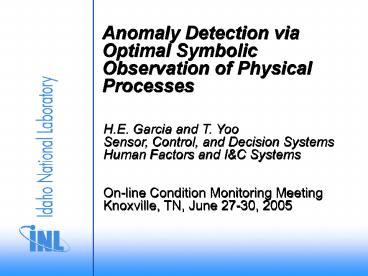Anomaly Detection via Optimal Symbolic Observation of Physical Processes
1 / 26
Title:
Anomaly Detection via Optimal Symbolic Observation of Physical Processes
Description:
Formally guarantee observability requirements and constraints ... Formal definitions of various observability properties ... different observability costs ... –
Number of Views:48
Avg rating:3.0/5.0
Title: Anomaly Detection via Optimal Symbolic Observation of Physical Processes
1
Anomaly Detection via Optimal Symbolic
Observation of Physical Processes
H.E. Garcia and T. YooSensor, Control, and
Decision SystemsHuman Factors and IC
SystemsOn-line Condition Monitoring
MeetingKnoxville, TN, June 27-30, 2005
2
Presentation Outline
- Motivation
- Developed rigorous framework, methodology, and
tool - Illustrative uses of developed technology
- Conclusions
- Future RD
3
On-line Condition Monitoring
- Design problem
- Find (optimal) sensor configurations that can
detect special (e.g., abnormal) events and/or
behaviors - Current solution
- Sensors are installed to detect anomalies without
optimizing information costs and assuming full
observability of specified events/behaviors - Proposed solution
- Optimal Symbolic Observation technique
- Design gather information from an optimal
sensing network configuration - Formally guarantee observability requirements and
constraints - Integrate and analyze process information
automatically - Detect concerned anomalies based on both observed
and recorded data
4
On-line Symbolic Condition Monitoring Technique
5
Symbolic Process Modeling
6
Observability Requirements and Costs
- Requirements (P and S)
- Report the occurrence of specified
events/behaviors in S while meeting specified
observability properties/demands P
(e.g., detection, diagnosis) - Monitor for operational specifications violations
- Detect process/operations anomalies
- Cost functional (C)
- Sensor costs and constraints
- Instrumentation preferences
7
Developed technique Verification
8
Developed technique Design Implementation
9
Optimal Symbolic Observation of Physical Processes
10
Flow chart of developed sensor optimization
framework
11
Rigorous condition monitoring frameworkFormal
definitions of various observability properties
- Illustrative example Uniform 1,
?-diagnosability - A prefix-closed language L(G) is said to be
uniformly 1, ?-diagnosable with respect to a
mask function M and ?f on S if the following
holds - (? i ? ?f )(? ndi ? N )(? s ? L )(? t ? L/s )
- t ? ndi ? D?
- where N is the set of non-negative integers and
the diagnosability condition D? is - D? (? w ? M-1M(st) ? L ) Niw ? Nis
12
Rigorous condition monitoring frameworkDevelopme
nt of mathematical algorithms
- Algorithms for verifying various observability
properties - Uniform and non-uniform 1, ?-diagnosability/dete
ctability - Supervisory observability
- Algorithms for sensor configuration optimization
- Search sensor set space rather than mask function
space - Algorithms for online anomaly detection
- Algorithms for addressing unreliable sensors
13
Example 1 Event anomaly monitoring
- Two types of material
- Blue (e.g., LEU material)
- Red (e.g., TRU material)
- Authorized material flows
- for the given monitored area
- Facility assumptions
- One input port I1
- Two output ports O1, O2
- Four internal stations S1, S2, S3, S4
14
Example 1 Event anomaly monitoring
- Monitoring requirements
- The additional two (2) possible material
movements (iS, i 1, 2) should not be executed
and must be detected (with no miss detection, no
false alarm).
15
Developed technique Design Implementation
16
Example 1 Event anomaly monitoring ad hoc vs.
optimized solution
Ad hoc design
Optimized design
17
Example 1 Event anomaly monitoring different
observability requirements
Diagnosability
Detectability
18
Example 1 Event anomaly monitoring different
observability costs
Diagnosability - C no previous-location sensors
AND minimize inside type sensors
Diagnosability - C no previous-location sensors
19
Example 1 Event anomaly monitoring - unreliable
(motion) sensor
C Reliability of motion sensor in S1 gt 60 P
Detection probability gt 90
C Reliability of motion sensor in S1, O1 40 lt
x lt 60 P Detection probability gt 90
20
Example 2 Specification integrity monitoring
- System Components Pump, Tank, Valve 1, Valve
2, Components Interaction
21
Example 2 Specification integrity monitoring
ModelingSymbolic component model Valve 1
22
Example 2 Specification integrity monitoring
SpecificationsSpecification 1 (S1) Do not
start Pump when Valve 1 is closedSpecifi
cation 2 (S2) Do not close Valve 1 when Pump is
running
23
Developed technique Design Implementation
24
Summary
- A condition monitoring technique has been
developed for - Rigorous assessment of intrinsic observability
properties - Objective-driven, model-based, systematic design,
evaluation, and implementation of optimized
condition monitoring systems that guarantee
observational requirements constraints - Information management optimization
- Reduce instrumentation costs
- Decrease operability intrusiveness
- Increase automation and flexibility
- Generated data analysis algorithms (with
associated sensors) can be incorporated in
on-line condition monitoring systems to
automatically integrate and analyze sensor data - On-line condition monitoring can be used as a
complementary process-integrity vigilant to
improve safeguards effectiveness
25
Benefits of Proposed On-line Condition Monitoring
Technique
- Rich design analysis capability
- Amenable to optimization, sensitivity, what-if,
and vulnerability analyses - Different monitoring objectives, such as
detectability, diagnosability, and supervisory
observability, can be selected and/or combined - Theoretical framework to guarantee mathematical
consistency and intended monitoring performance - Objective-driven, model-based, systematic
approach to deal with system complexity (e.g.,
Rokasho plant 13,000 measurements) - Enhance decision-making by using available
knowledge and both observed and recorded data - Enable portability and standardization
26
Future RD
- Current capabilities
- Certainty in observation (e.g., reliable sensors)
- Design goal no miss-detection, no false alarm
- Uncertainty in observation (e.g., unreliable and
noisy sensors) - Design goal meet statistical specification
regarding detection probability (miss-detection) - Future capabilities
- Consider statistical specification regarding
false alarm rates - Add temporal information (e.g., to detect
temporal anomalies) - Add process and operations uncertainties
- Further develop and evaluate the on-line
condition monitoring technique based on the
symbolic dynamic analysis of process signals















![L 34 Modern Physics [1]](https://s3.amazonaws.com/images.powershow.com/7125701.th0.jpg?_=20150905079)















